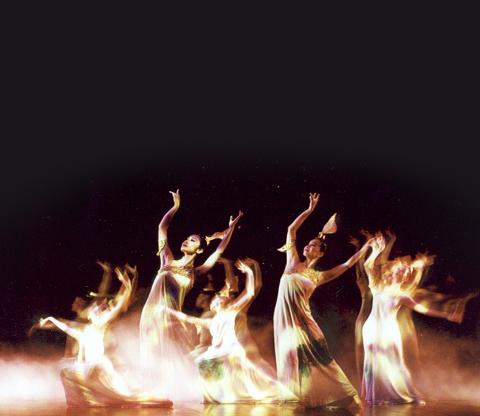The Taipei Folk Dance Theatre (台北民族舞團) opens a three-show run of The Divine Chant for the Centenary (百年香讚) at Taipei’s Metropolitan Hall tomorrow afternoon, yet another in the list of events celebrating the 100-year anniversary of the Republic of China.
The troupe’s latest production is no paean to patriotic fervor, but rather a continuation of founder-artistic director Tsai Li-hua’s (蔡麗華) musings on Buddhism and a “Chan [Zen] dance style.”
Tsai founded the company in 1988 as the country’s first professional ethnic dance troupe with a mission to preserve and promote the nation’s dance heritage, including both traditional Chinese and Aboriginal dances. Starting in 2000, however, she began a series of productions that focused on developing a Chan dance style, including last year’s The Blossoming Smile of Enlightenment (拈花微笑), that draw on Chan Buddhist scriptures and stories.

Photo Courtesy of Taipei Folk Dance Theatre
She was also inspired this year by Yuan Dynasty artist Huang Gongwang’s (黃公望) landscape painting Dwelling in the Fuchun Mountains (富春山居圖), which was famously reunited in June at the National Palace Museum after being split apart four centuries ago. Seeing the painting, which is considered Huang’s meditation — at age 82 — on retirement, made Tsai think about her own retirement earlier this year from her full-time job as a university professor. Her new work, influenced by Huang’s painting, is titled Forgetting (忘機).
Another piece by Tsai is the “lotus dance” segment from her 2000 work Dream World (菩提), which she added to the program just in August after learning of the death of composer Gerald Shih (史擷詠), whose music she used for the piece. Shih, a prolific composer for film, dance and theater, died on Aug. 22 at age 53.
Two works on the program are by Tsai’s frequent collaborators, Hsiao Chiin-ling (蕭君玲) and Hu Min-shan (胡民山) — who worked on last year’s production — and another is by Wang Lei-chien (王蕾茜).
Hsiao’s piece is titled Fragrant Praise (香讚), Hu contributed Avalokitesvara (觀自在) and Wang’s piece is called Floating Jade (浮玉).
Taipei Folk Dance Theatre spent much of September performing in the US, including a stop in San Antonio, Texas, to take part in that city’s Year of Taiwan celebrations, as well as East Coast shows in New York City and New Jersey.
The troupe will be hitting the road again after this weekend, this time just in Taiwan, taking The Divine Chant for the Centenary to Greater Taichung and Greater Kaohsiung later this month.

In the March 9 edition of the Taipei Times a piece by Ninon Godefroy ran with the headine “The quiet, gentle rhythm of Taiwan.” It started with the line “Taiwan is a small, humble place. There is no Eiffel Tower, no pyramids — no singular attraction that draws the world’s attention.” I laughed out loud at that. This was out of no disrespect for the author or the piece, which made some interesting analogies and good points about how both Din Tai Fung’s and Taiwan Semiconductor Manufacturing Co’s (TSMC, 台積電) meticulous attention to detail and quality are not quite up to

April 21 to April 27 Hsieh Er’s (謝娥) political fortunes were rising fast after she got out of jail and joined the Chinese Nationalist Party (KMT) in December 1945. Not only did she hold key positions in various committees, she was elected the only woman on the Taipei City Council and headed to Nanjing in 1946 as the sole Taiwanese female representative to the National Constituent Assembly. With the support of first lady Soong May-ling (宋美齡), she started the Taipei Women’s Association and Taiwan Provincial Women’s Association, where she

Chinese Nationalist Party (KMT) Chairman Eric Chu (朱立倫) hatched a bold plan to charge forward and seize the initiative when he held a protest in front of the Taipei City Prosecutors’ Office. Though risky, because illegal, its success would help tackle at least six problems facing both himself and the KMT. What he did not see coming was Taipei Mayor Chiang Wan-an (將萬安) tripping him up out of the gate. In spite of Chu being the most consequential and successful KMT chairman since the early 2010s — arguably saving the party from financial ruin and restoring its electoral viability —

It is one of the more remarkable facts of Taiwan history that it was never occupied or claimed by any of the numerous kingdoms of southern China — Han or otherwise — that lay just across the water from it. None of their brilliant ministers ever discovered that Taiwan was a “core interest” of the state whose annexation was “inevitable.” As Paul Kua notes in an excellent monograph laying out how the Portuguese gave Taiwan the name “Formosa,” the first Europeans to express an interest in occupying Taiwan were the Spanish. Tonio Andrade in his seminal work, How Taiwan Became Chinese,